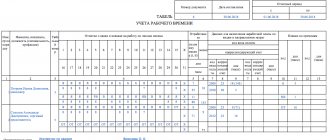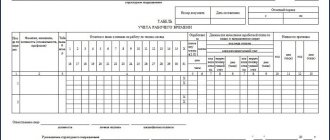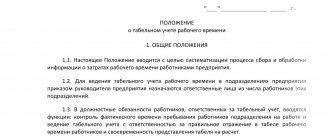08.07.2019
0
224
5 minutes.
If an employee is not at the workplace legally, and his salary is not accrued, then such points must be correctly displayed in the accounting sheet. The difficulty lies in the fact that there are several options for providing an employee with rest without making cash payments by the employer. All the nuances of going on leave without pay will be discussed in detail below.
What do abbreviations mean?
The code in the document recording the hours of work of employees at the workplace is necessary to correctly fill out the register. For this purpose, letter designations are adopted in the working time sheet; they are indicated in the article containing methodological recommendations to Order of the Ministry of Finance of Russia dated March 30, 2015 No. 52n.
For example, the designation in the T-13 time sheet for absenteeism is “P”. And the letters “DO” stand for leave without pay.
We have collected all the symbols of the report card in the table.
| Codes in the T-13 time sheet from 2021 | Decoding |
| A | Absences with permission from the administration |
| B | Temporary disability, disability due to pregnancy and childbirth |
| IN | Weekends and non-working holidays |
| G | Carrying out government duties |
| TO | Business trips |
| N | Night work |
| ABOUT | Regular and additional holidays |
| OB | Additional paid days off |
| BEFORE | OT at your own expense |
| R | P in the report card (decoding) - maternity leave |
| coolant | OO in the report card (decoding) - parental leave |
| P | Absenteeism |
| WITH | Overtime hours |
| NN | Absences for unknown reasons (until the circumstances are clarified) |
| VU | Study weekend |
| OU | Additional study leave |
| PC | Off-the-job training |
| ZN | Substitution in grades 1-3 |
| Salary | Substitution in after-school groups |
| ZS | Substitution in grades 4-11 |
| RP | Work on weekends and non-working holidays |
| F | Actual hours worked |
| Champions League | Code for indicating hours of reduced labor for employees |
We suggest saving the image with the codes as a cheat sheet. It contains a complete transcript of the 2021 time sheet.
Articles on the topic (click to view)
- Fine for late payment of vacation pay
- What to do with unused vacation
- What to do if your employer does not pay vacation pay
- How long after employment is vacation allowed?
- Is maternity leave taken into account when calculating pensions?
- Accounting for compensation for unused vacation
- Dismissal while on maternity leave
How to mark correctly on a report card
The order of designation in the T-12 form:
Designation order in form T-13
How to indicate vacation on the report card if sick leave occurs
The illness of an employee on vacation at his own expense is not a reason for issuing a certificate of incapacity for work and its subsequent payment; the vacation period is not extended. A slip can be issued to an employee at the end of his vacation period without pay, if at the time of its end the employee’s illness has not ended.
A different procedure applies to the main annual vacation, when sick leave is payable and the vacation period is extended.
That is, the actual illness of an employee who took days off at his own expense, occurring during a period of rest without pay, does not in any way affect the designation in the work time sheet. The days when the employee was sick while on leave at his own expense are indicated in the timesheet with the same codes as the unpaid leave itself: DO and 16 or OZ and 17.
If the employee is on annual leave, then sick days that fall during the vacation period are indicated in the working time sheet as follows:
- code B or 19 for sick leave with payment of benefits;
- code T or 20 for sick leave without payment of benefits.
Read more about sick leave during unpaid leave.
Can I use my own abbreviations and decodings?
Many specialists are interested in whether it is possible to add their own codes for the 2021 working time sheet. If necessary, the enterprise has the right to independently supplement the adopted abbreviations (according to article of the Order of the Ministry of Finance of Russia dated March 30, 2015 No. 52n).
For example, to designate a vacation period, the code “O” must be entered - regular and additional leaves or “OR” - for child care. For convenience and to differentiate between types of leave, specialists enter “DO” into the designation, which means leave at their own expense; the designation is quite often used in the time sheet. Or “KR” - a break to feed the baby.
When introducing additional values, it is necessary to issue an order to approve the designations, thus securing the new codes and their interpretation of the movements of employees in the workplace in local regulatory documents.
Filling out the document using codes
- Using the method of continuous registration of attendances and absences, every work day and day off in the reporting month is noted. The code and number of hours worked on site are entered.
The choice of methodology for drawing up the form is determined by the personnel and accounting policies of the organization. The decoding of the codes, as well as the method of filling out the document, must be fixed in the local regulatory provisions of the institution.
It is necessary to remember the basic rules for filling out the document:
- Changes in the payroll (last name, position, work schedule) are entered into the form on the basis of orders for personnel.
- If an employee has two types of deviations in one working day, the entry is made using a fraction, where the numerator of the fraction is the code, and the denominator is the hours of work. For example, code H/2 means that the employee worked 2 hours at night. In case of more than two deviations, you must enter an additional line for this employee and reflect the deviation in the document.
- In the “Type” line it is indicated: during initial filling, the digital code “0”; when adjusting, starting from one, the code “1”, “2”, etc. is entered.
Letter designations in the report card
Selection of the most important documents upon request Letter designations in the report card
(regulatory legal acts, forms, articles, expert consultations and much more).
Regulatory acts: Letter designations in the report card
Articles, comments, answers to questions: Letter designations in the report card
The document is available: in the commercial version of ConsultantPlus
How to fill out a time sheet?
The time sheet not only reflects the number of hours worked by each employee, but also allows you to record information about attendance and absence from work on a daily basis.
Some of the employees fell ill, some were absent for unknown reasons, and some went on vacation. Let's see how to correctly mark all these cases on the report card.
All organizations are required to maintain time sheets. This document is required in order to:
The State Statistics Committee of Russia has approved two unified forms for time sheets - T-12 and T-13*. The forms differ in that T-12 is a universal option, and T-13 is carried out if the organization has an automatic system for monitoring attendance and no-shows at work (turnstile). In this case, the data is entered into the form via a computer. Most often, of course, they use the T-12 form, since access systems are not installed in all organizations.
The report card is compiled in one copy. At the end of the month, the completed report card must be signed by the heads of structural divisions and the HR employee. The document is then sent to the accounting department for payroll calculation.
Who keeps the timesheet
Previously, many organizations had a special position - timekeeper. Now managers consider it irrational to maintain a separate staffing unit only for recording exits and absences from work. Most often, the responsibility for keeping time sheets is assigned to a human resources specialist, accountant or heads of structural divisions in addition to their main functions. Remember that this responsibility must be enshrined in the employment contract and job description of the employee or assigned to him by order of the director of the organization.
How to reflect the use of working time in a timesheet
Forms T-12 and T-13 practically do not differ in the composition of the details, so we will consider filling out the timesheet using the example of one form - T-12. Or rather, its first section, which is called “accounting for the use of working time.” A sample of filling out the timesheet is given on page ....
The time sheet is kept for a month, and at the end of this period it summarizes the number of hours worked by each employee. Interim results are also noted (for the first and second half of the month). Attendances and absences from work are recorded using the continuous registration method. This means that for each day of the month, some designation is entered in the corresponding cell - attendance or failure to appear for certain reasons (or due to unclear circumstances). However, it is also possible not to mark attendance, but to register only deviations from the work schedule (no-shows, tardiness, etc.). If there were no deviations during the month, then the report card will reflect only the final data on the results of work for the first and second half of the month and the overall result, and the other cells will remain empty.
Now let's see exactly how to enter the designations in the report card.
In columns 4 and 6 of the T-12 form there are two lines. The top line contains a letter designation of the types of working time spent on each day of the month (appearance, vacation, business trip, sick leave, etc.). The number of hours for them is recorded at the bottom. The letter designations are given on the title page of the T-12 form. For example, if an employee came to work on June 13 and was present full-time, then in the report card for June in the cell with the number 13 opposite the employee’s last name we will put “I” and 8 working hours. If he was on a business trip that day, then it is necessary to put “K”. But he did not have working hours in your organization that day, so we put zero in the bottom line. Weekends and holidays also have their own designation. The top line is marked with “in” and the bottom line with zeros.
Remember: to put down this or that code, you must have good reasons. For example, you can mark sick leave on your report card only if you know for sure that the employee has a certificate of temporary incapacity for work.
The table on page ... provides a list of documents for all cases of absences and deviations from the established work schedule. If you do not have documents confirming the reason for the employee’s absence, then you can only note in the report card absence for unknown reasons (“NO”).
The symbols of worked and unworked time, which are presented on the title page of form T-12, are also used in form T-13
How to summarize
At the end of the month, you need to calculate the total number of days and hours worked. At the same time, weekends, absenteeism, absences for unknown reasons, sick days, business trips are excluded from the calculation of days worked - in general, all those days when the employee was absent from work. To calculate the number of hours worked, you simply need to add up the numbers in the second line of columns 4 and 6, and enter the results in column 5 (for the first half of the month), column 7 (for the second half of the month) and columns 8-13 (for the month as a whole) .
Separately, you need to calculate the number of days of no-shows and enter information about them in columns 14-16. Column 15 contains numerical codes for the reasons for non-appearance (these codes are given on the title page of the form, along with the letter designations). For example, the code for regular vacation is 09, and absence for unknown reasons is 30. And finally, it is necessary to determine the total number of days off for each employee for the month and enter it in column 17.
*Resolution of the State Statistics Committee of Russia dated January 5, 2004 No. 1.
More on the topic:
- Code of Administrative Offenses of the Russian Federation 2020 fine Is it possible to pay a fine for drinking alcohol in a public place with a 50% discount? Is it possible to pay a fine for drinking alcohol in a public place with a 50% discount? with with […]
- Commentary on Article 32 of the Code of Administrative Offenses Article 32.2. Execution of the decision to impose an administrative fine ST 32.2 of the Code of Administrative Offenses of the Russian Federation 1. The administrative fine must be paid in full by the person brought to [...]
- Clause 1 of Article 16 of the Russian Federation Article 16 Measures of social support for combat veterans Information about changes: Federal laws of August 22, 2004 N 122-FZ and of December 29, 2004 N 199-FZ in Article 16 […]
- Labor Code 122 Article amendments Labor Code of the Russian Federation with comments Commentary on Article 122 § 1. The editorial change affected Part 2 of Art. 122. The words “in this organization” are replaced by the words “at this […]
- Oktyabrsky Magistrate's Court, precinct 1, Murmansk Judicial precinct No. 1 of the Oktyabrskiy judicial district of Murmansk In accordance with the Law of the Murmansk Region dated October 4, 2002 No. 363-01-ZMO “On the creation of judicial precincts and positions [...]
- Art. 192 Labor Code of the Russian Federation p1 Article 192. Disciplinary sanctions Labor Code (Labor Code of the Russian Federation) verified today code dated 10/22/2018 entered into force 02/01/2002 Art. 192 of the Labor Code of the Russian Federation in the latest valid edition dated 1 […]
Examples of designating leave without pay in a time sheet
Expert opinion
Polyakov Pyotr Borisovich
Lawyer with 6 years of experience. Specialization: civil law. More than 3 years of experience in drafting contracts.
Russian legislation provides for several types of leave, each of which the accountant must correctly indicate on the timesheet. One of these types includes the release of an employee from work without accrual of earnings, but with the preservation of his job.
Leave without pay should be indicated in the timesheet with the correct codes, this will allow the accountant to correctly calculate wages.
The article describes typical situations. To solve your problem , write to our consultant or call for free:
How are working hours recorded?
If there are compelling reasons for registration, the manager cannot refuse the employee (marriage, birth of a child, death of a relative) - the procedure for granting leave without pay.
To confirm the circumstances, the employee provides, along with the application, the necessary papers that serve as the basis for reflecting this fact in the documentation.
After issuing an order on leave without pay, the contents of which must be familiarized to the employee, the personnel service notes changes in the personal card, and the corresponding codes are entered in the personal time sheet.
Information is entered into the document every day, at the end of the month the results for each employee are summed up (days worked and dates of absence from work) and wages are calculated.
You should be aware that not the entire vacation period without pay is reflected equally in the report card (depending on the grounds).
Designation of leave without pay
All absences of a worker from the workplace are reflected in the time sheet in the form of a letter or number. Accounting documents do not require strict completion of a particular symbol or code. The HR department independently determines the procedure for keeping records of working hours.
In the employee's report card, time off without pay is indicated as follows:
- letter designation “ZO” or digital code “17” , if unpaid leave must be provided to the employee even without the approval of the organization’s management (Article 128 of the Labor Code of the Russian Federation);
- the designation “DO” or code “ 16” is placed with the mutual consent of the employer and employee to arrange a vacation at their own expense.
There are several more symbols that display vacation time without pay on the time sheet:
- “UD” or 13 - unpaid educational leave;
- “NB” or 35 - inadmissibility to work on legal grounds;
- “DB” or 18 - annual unpaid leave.
The latter should not be confused with the holidays prescribed in Article 128 of the Labor Code (Part 2). This rest is provided to volunteer firefighters, labor heroes, holders of the Order of Glory, and child care, if this is stated in the collective agreement.
Vacation at your own expense when working in shifts
A shift from 20.00 to 8.00 the next day is two calendar days.
Judge for yourself, who will agree to replace an employee from 12 o'clock at night?
Working a full shift from 20.00 to 8.00 is normal, but it’s unlikely that anyone will want to get to their workplace at night.
And then - unpaid leave is provided in calendar days, and in this situation you will have to provide leave for 4 hours of an 11-hour shift.
Therefore, the employee needs to write an application for leave for 2 calendar days, which includes a night shift, and not force the employer to puzzle over how to apply for it
Quote: Article 128. Leave without pay
For family reasons and other valid reasons, an employee, upon his written application, may be granted leave without pay, the duration of which is determined by agreement between the employee and the employer. The employer is obliged, on the basis of a written application from the employee, to provide leave without pay to: participants of the Great Patriotic War - up to 35 calendar days
per year;
for working old-age pensioners (by age) - up to 14 calendar days
per year;
parents and wives (husbands) of military personnel, employees of internal affairs bodies, the federal fire service, authorities for control of the circulation of narcotic drugs and psychotropic substances, customs authorities, employees of institutions and bodies of the penitentiary system, killed or died as a result of injury, concussion or injury, received while performing the duties of military service (service), or as a result of an illness associated with military service (service) - up to 14 calendar days
a year;
(as amended by Federal Law No. 157-FZ dated 02.07.2013) (see text in the previous edition) for working disabled people - up to 60 calendar days
a year;
employees in cases of the birth of a child, marriage registration, death of close relatives - up to five calendar days;







